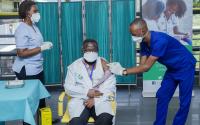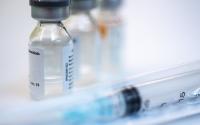[ad_1]
Table of Contents
Study: US COVID infections may have been twice the number reported
Roughly 15.9 million asymptomatic US COVID-19 cases may have gone undetected as of Sep 30, 2020, which would double the cases reported to the Centers for Disease Control and Prevention (CDC) during that time, according to a research letter detailing a 6.6% nationwide SARS-CoV-2 seroprevalence rate.
The letter, written by Clinical Reference Laboratory scientists in Kansas and published today in JAMA Network Open, describes a national convenience sample of 61,910 generally healthy adult life insurance applicants evaluated for the presence of SARS-CoV-2 antibodies in September.
Of the 61,910 participants, 4,094 (6.6%) had coronavirus antibodies, or were seropositive, indicating previous COVID-19 infection. Slightly more women than men were seropositive (6.9% vs 6.4%). Seroprevalence rates varied widely by state and ranged from 2.8% in participants older than 70 years to 9.8% in those younger than 30.
Using this sample, the researchers estimated that 15.9 million (bootstrap 95% confidence interval, 15.5 million to 16.5 million) asymptomatic or undiagnosed COVID-19 infections may have occurred.
The authors noted that antibody testing may provide a more accurate estimate of coronavirus prevalence than acute COVID-19 testing because people with asymptomatic or mild illness may not get tested for infection. They added that the study findings also highlight the need for ongoing population-wide disease surveillance.
“Our estimate implied more than twice the number of infections than cases reported to Centers for Disease Control and Prevention, suggesting a more widespread pandemic,” the researchers wrote. “The findings of this cross-sectional study suggest that, based on a sample from an otherwise healthy population, the overall number of SARS-CoV-2 infections in the US may be substantially higher than estimates based on public health case reporting.”
Mar 16 JAMA Netw Open research letter
Low immune response noted in transplant recipients after COVID vaccine
Out of 436 solid organ transplant recipients, 82.6% did not have detectable antibody responses after the first dose of an mRNA COVID-19 vaccine, according to a JAMA research letter published yesterday.
Immunocompromised people have not been included in the trials for the Pfizer/BioNTech or Moderna mRNA COVID vaccines, so the researchers recruited US transplant recipients and gave them a first dose of either vaccine from Dec 16, 2020, to Feb 5, 2021. The median age of participants was 55.9, and 89% were white. Kidney (50.2%), liver (17.9%), and heart (15.1%) were the most common organ transplants, and the median time since the transplant was 6.2 years.
After a median of 20 days post-vaccination, serologic tests showed that 17.4% of participants had detectable antibody levels, but some patient factors affected this. For instance, 73.4% of participants were on an anti-metabolite maintenance immunosuppression regimen, which was associated with an adjusted incidence rate ratio (IRR) of 0.22 (95% confidence interval [CI], 0.15 to 0.34). Older participants were also less likely to display an immune response (aIRR, 0.83; 95% CI, 0.73 to 0.93 per 10 years).
The study did note that the 48% of the cohort who received the Moderna vaccine were more likely to develop an antibody response than the 52% who received the Pfizer/BioNTech vaccine (aIRR, 2.15; 95% CI, 1.29 to 3.57). The researchers did not suggest a possible mechanisms for this finding.
“These findings of poor antispike antibody responses in organ transplant recipients after the first dose of mRNA vaccines suggest that such patients may remain at higher early risk for COVID-19 despite vaccination,” they conclude.
Mar 15 JAMA research letter
Pandemic tied to lower-than-optimal care of newborns
Two thirds of respondents to a survey on neonatal care during the pandemic said they would not facilitate Kangaroo Mother Care (KMC), which is skin-to-skin contact that can help preterm babies, according to a study published yesterday in BMJ Global Health.
The results also highlight uncertainties around guidelines for suspected or confirmed COVID-19–infected mothers, staff and resource shortages, and an overall 20% to 35% reduction of neonatal care.
The survey was conducted from Jul 13 to Oct 13, 2020, and included 1,120 healthcare workers, public health professionals, and policymakers from 62 countries, with an emphasis on low- and middle-income countries (LMICs).
Before the pandemic, KMC was routinely practiced by 85% of respondents, but it has since dropped to 55% in part due to earlier discharge (30.8%), reduced duration of skin-to-skin contact (26.5%), and complete disruption of KMC services (7%). Almost two-thirds (61.0%) said they would separate neonates and mothers with unknown, suspected, or confirmed COVID except when breastfeeding, and 24.1% said they would separate and prohibit breastmilk regardless of the mother’s COVID status.
The survey also revealed that 44.6% of respondents thought that guidance around COVID-infected mothers was “somewhat clear but major issues remain” or worse.
“Our data show huge promise for many lives saved with universal KMC, so it’s vital that we use this opportunity to strengthen care now and build back better after the pandemic,” said lead author Suman P. N. Rao, MD, in a London School of Hygiene & Tropical Medicine (LSHTM) press release. She and senior author Joy Lawn, BMedci, MB, PhD, MPH, also contributed to a Feb 15 EClinicalMedicine paper that found continuing KMC despite COVID-19 risk could save more than 125,000 neonate lives, at the risk of up to 1,950 neonatal COVID deaths. They thus concluded that the benefit of providing KMC is 65 to 630 times higher than the risk of dying from COVID-19.
Survey respondents listed family reluctance to come on site and COVID-19 testing delays or unavailability as disrupting neonatal care. Respondents also report that staffing and resources reallocated to meet COVID-19 needs have affected care.
Mar 15 BMJ Glob Health study
Mar 15 LSHTM press release
[ad_2]
Source link












